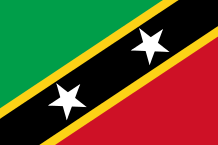ST KITTS & NEVIS
 St Kitts’ area is 176 sq km. In the centre of the island, there is range of mountains. The highest point is Liamuiga Mount (1 156 m), an extinct volcano whose high sides are covered with a rainforest. Nevis’ area is 93 sq km. In the centre of the island, there is Nevis Peak (985m).
St Kitts’ area is 176 sq km. In the centre of the island, there is range of mountains. The highest point is Liamuiga Mount (1 156 m), an extinct volcano whose high sides are covered with a rainforest. Nevis’ area is 93 sq km. In the centre of the island, there is Nevis Peak (985m).
The landscapes in St Kitts are various : grass and plants in the valleys and in the coast ; ferns and tall trees in the humid forest.
In Nevis, if the tropical forest is in the mountainous region, the coast is rather dry and occupied by flowers (bougainvilleas, hibiscus…) or cacti. In St Kitts and Nevis, there are vervet monkeys, frigates, pelicans, hummingbirds, racoons…
The main economic activities in St Kitts are sugar cane production, tourism, little clothes factory and electronics assembling factory.
Tourism is an important part of Nevis’ economy. There are also a production of honey, vegetables, cotton. The growing of sugar cane has been stopped.
St Kitts was called “Liamuiga” (Fertile Island) by the Carib Indians. Christopher Columbus discovered the island in 1493 during his second voyage to the New World and named it St Christopher after his patron Saint. The seafarer drew his inspiration from the snow (nieve, en Spanish) to name Nevis because of the clouds at the top of Nevis Peak. The Carib Indians called this island “Ouali” (Land of Beautiful Waters).
In 1623, St Kitts became the first British colony in the West Indies when Sir Thomas Warner colonized the island. In 1624, a French colony settled in St Kitts too, Warner did not react because he beleived that the Caribs would be more controled by the situation.
Five years after he settled in St Kitts, Thomas Warner asked one hundred of English colonists to occupy Nevis. In 1680, an earthquake destroyed the first village located on the west coast near to Cotton Ground but with the labor of Africa slaves in the sugar cane fields, Nevis became the island where lived the richest settlers of the Eastern Caribbean.
In the 18th century, the good reputation of Nevis thermal baths attracted rich and famous people.
But, during several conflicts with the Europeans, the Amerindians were massacred. Then, England and France waged war to conquer St Kitts. The island changed owner several times before it became British by the 1783 Treaty of Versailles.
In 1816, St Kitts, Nevis, Anguilla and the British Virgin Islands made up only one colony by Great Britain decision. They joined the West Indies Federation, in 1958. In 1962, this federation was dissolved but England chose to keep St Kitts, Nevis and Anguilla in only one colony. In 1967, these three islands became independent with Basseterre (in St Kitts) as capital. Anguilla rebeled against this decision and decided to be again a British Overseas territory. Nevis, after a trial period and a more important autonomy, accepted to unite with St Kitts.
In 1983, St Kitts and Nevis constituted an independent state which is led by a Prime Minister. The country belongs to the Commonwealth.
Area : St Kitts : 176 sq km (68 sq miles) / Nevis : 93 sq km (36 sq km)
Population : 46 000 inhabitants (St Kitts : 35 000 / Nevis : 11 000)
Capital : Basseterre (St Kitts) ; Charleston (Nevis)
Languages : English (official) – Patois
Currency : Eastern Caribbean Dollar (EC$)
People : Kittitians / Nevisians
